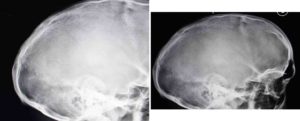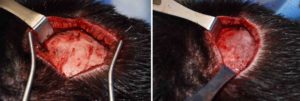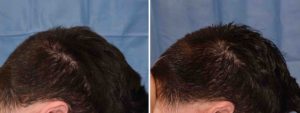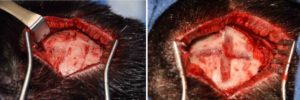Background: The back of the head can have a variety of contour deformities. One such deformity is that of excessive protrusion. This is where the back of the head exceeds what would be considered a normal convex curve. While there is no exact numerical measurement to determine what is or is not excessive, it is always visually apparent. In the end if the patient feels it is excessive, then it is.
Some occipital protrusions do have a known cause and the scaphocephalic head shape is one of them. This is where the head is elongated from front to back and is narrow from side to side. This is caused by premature closure variations of the sagittal suture. While significant sagittal suture closure is known as craniosynostosis and requires easily cranial vault surgery, many less severe variations exist.
One important question is whether the elongated back of the head has a normal, more than normal or less than normal bone thickness. A x-ray will answer that question. Although in scaphocephaly the elongation should not cause the bone to have an abnormal thickness or thinness. For the purposes of surgical reduction, however, it would be preferred that the bone was thicker.



Case Highlights:
1) Protrusions on the back of the head can occur from a variety of developmental reasons, one of which is a scaphocephalic skull shape.
2) How much occipital skull reduction can be done can be assessed before surgery with an x-ray.
3) All skull reductions consist of an outer table corticotomy down into the diploic space.
Dr. Barry Eppley
Indianapolis, Indiana



